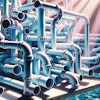It’s one of nature’s miracles that resides at the heart of balanced ecosystems on every continent except Antarctica. Known generally as the “wetlands effect,” it’s the process through which plants absorb nutrients from water and, among other things, it’s why natural wetlands associated with lakes, rivers and oceans are so critical environmental health.
Wetlands are loosely defined as areas where soil is saturated with water giving rise to scores of plant and animal species, including a range of beneficial microorganisms. Through a chemical process known as “dentrification” or the “nitrogen cycle” plants and microorganisms work together to transform and absorb nitrogen-based compounds, the primary component of contamination that results in massive algal blooms that rob water of oxygen required to sustain diverse ecosystems.
How effective is this process? Various studies indicate that contaminated water passing through riparian wetlands can see chemical level reduction measuring more than 85 percent. That process of chemical uptake can spell the difference between healthy bodies of water, both fresh and saltwater, and those that are nearly devoid of life.
Humans have been using the wetlands effect in various ways dating back to the ancient Egyptians, long before we were worried about the effects of agricultural and industrial contamination. These days, the wetlands effect is used widely across a range of applications and offers a set of elegant solutions to problems associated with mass population growth and the resulting scarcity of food resources.
Not only do natural wetlands serve as the ultimate chemical filters, man-made systems are now also commonplace as an alternative to mechanical filtration and chemical treatment. One example, people who build ponds and streams will create massive biological filters in the form of bogs, which do the lion’s share of maintaining quality water. A similar approach is now being used to create “Natural Swimming Pools” in which small wetlands or “regeneration zones” are used to filter water. And in yet another application, man-made floating islands that contain specific plant species are used to clean contaminated bodies water, as well as providing habitats for fish, birds, insects and water-loving land animals.
One of the more exciting applications these days is found in the emerging science of Aquaponics. The term is a hybrid between Aquaculture, the science of growing fish and other aquatic species, and Hydroponics, the science of growing plants without soil, using nutrient-rich water.
Aquaponics combines the two into a nearly self-sustaining system in which populations of fish are maintained to load water with nutrients that is transformed by bacteria into nitrates, which is in turn circulated through crop roots to generate accelerated growth that’s not possible in traditional farming practices. After the plants have absorbed the nutrients, the water is returned to the fish tank and the cycle repeated.
Results vary depending on a variety of factors, but generally speaking, using Aquaponic systems, plants grow at twice the rate compared to conventional farming, they use no fertilizers and a mere two-to-five percent the water required in traditional farms.
Over the past ten years, following a groundbreaking study from the University of Virginia, numerous companies have emerged using Aquaponics for both commercial and residential applications. Systems can be tailored to help meet nutritional needs for individuals and/or their families in urban settings where systems can be located on balconies, patios, small yards and rooftops, or they can be upsized to generate mass production for restaurants and grocery stores.
The trend has been juiced by public concerns over GMOs and likewise driven by the demand for “organic” foods. The dramatic reduction in water usage has further driven interest in regions impacted by drought, which at this writing is about half the continental U.S.
I recently spoke with Mark Kelly, founder of a commercial Aquaponics firm, Aqua Harvest Greens, and a charitable foundation known as the Two Fish Project. “Our goal is to establish the commercial operation providing produce for local restaurants and other outlets, which will serve as financial footing supporting the missionary work,” he explains. “The growth potential for both is almost unlimited.”
Indeed, a number of organizations are currently setting up Aquaponic systems in third world countries as a way to help orphanages, missions and other humanitarian organizations establish self-sustaining food sources for villages that are otherwise food insecure.
It’s a wonderful story, and certainly one worth exploring by anyone interested in growing their own food. But if I may indulge some constructive speculation, there may be another facet to Aquaponics that is yet unexplored, that being possible connection between the pond and stream industry and Aquaponic systems. In a sense, there could well be an analogy between Natural Swimming Pools, which as mentioned above use plantings and bacteria colonies to purify water, and ponds associated with Aquaponic systems.
I can’t help but wonder if existing and prospective pond owners were aware of the possibility, many might favor the idea of using their ponds containing fish as the nutrient component in an Aquaponics system. Marrying decorative ponds containing Koi, one of the fish species favored for Aquaponic use, with a growth operation should merely require adhering to a number of technical specifics, chiefly establishing a balance between the number of fish and amount of plant material supported by their waste.
Fortunately, based on the reams of information readily available covering the system requirements and parameters, the learning curve is relatively short and the initial investments in setting up a system relatively low. Anyone who knows how to build ponds, or even swimming pools for that matter, is already well on their way to owning the skillset required to build Aquaponic systems.
Given how powerful and adaptable the wetlands effect is in other settings, it would only make sense that the decorative water industries consider adapting some form of Aquaponics as an option for ecologically minded consumers.
If nothing else, consider the suggestion “fish” food for thought.








































